steering GMC YUKON HYBRID 2009 Owners Manual
[x] Cancel search | Manufacturer: GMC, Model Year: 2009, Model line: YUKON HYBRID, Model: GMC YUKON HYBRID 2009Pages: 94, PDF Size: 0.53 MB
Page 31 of 94
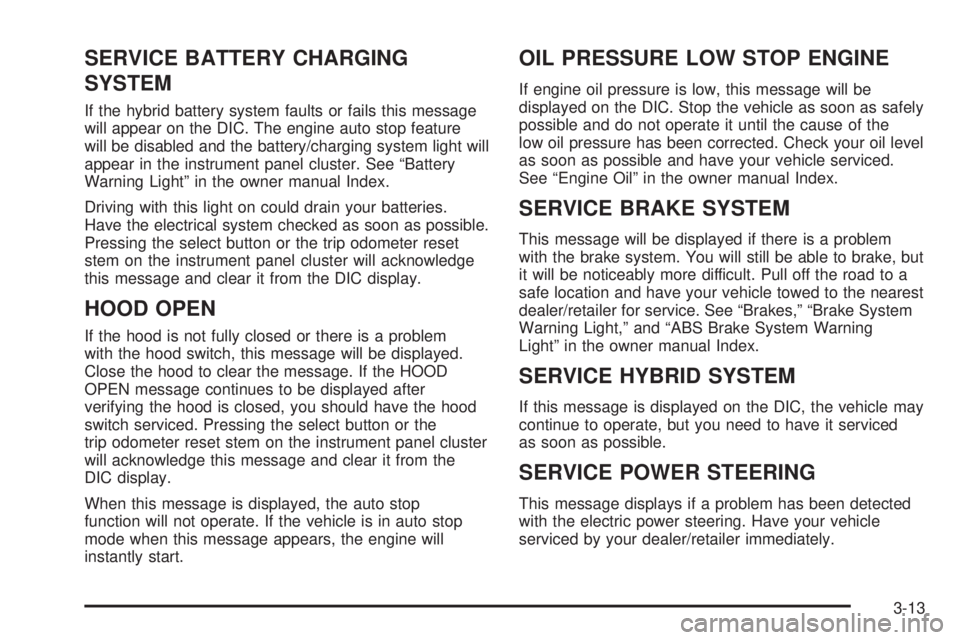
SERVICE BATTERY CHARGING
SYSTEM
If the hybrid battery system faults or fails this message
will appear on the DIC. The engine auto stop feature
will be disabled and the battery/charging system light will
appear in the instrument panel cluster. See “Battery
Warning Light” in the owner manual Index.
Driving with this light on could drain your batteries.
Have the electrical system checked as soon as possible.
Pressing the select button or the trip odometer reset
stem on the instrument panel cluster will acknowledge
this message and clear it from the DIC display.
HOOD OPEN
If the hood is not fully closed or there is a problem
with the hood switch, this message will be displayed.
Close the hood to clear the message. If the HOOD
OPEN message continues to be displayed after
verifying the hood is closed, you should have the hood
switch serviced. Pressing the select button or the
trip odometer reset stem on the instrument panel cluster
will acknowledge this message and clear it from the
DIC display.
When this message is displayed, the auto stop
function will not operate. If the vehicle is in auto stop
mode when this message appears, the engine will
instantly start.
OIL PRESSURE LOW STOP ENGINE
If engine oil pressure is low, this message will be
displayed on the DIC. Stop the vehicle as soon as safely
possible and do not operate it until the cause of the
low oil pressure has been corrected. Check your oil level
as soon as possible and have your vehicle serviced.
See “Engine Oil” in the owner manual Index.
SERVICE BRAKE SYSTEM
This message will be displayed if there is a problem
with the brake system. You will still be able to brake, but
it will be noticeably more difficult. Pull off the road to a
safe location and have your vehicle towed to the nearest
dealer/retailer for service. See “Brakes,” “Brake System
Warning Light,” and “ABS Brake System Warning
Light” in the owner manual Index.
SERVICE HYBRID SYSTEM
If this message is displayed on the DIC, the vehicle may
continue to operate, but you need to have it serviced
as soon as possible.
SERVICE POWER STEERING
This message displays if a problem has been detected
with the electric power steering. Have your vehicle
serviced by your dealer/retailer immediately.
3-13
Page 33 of 94
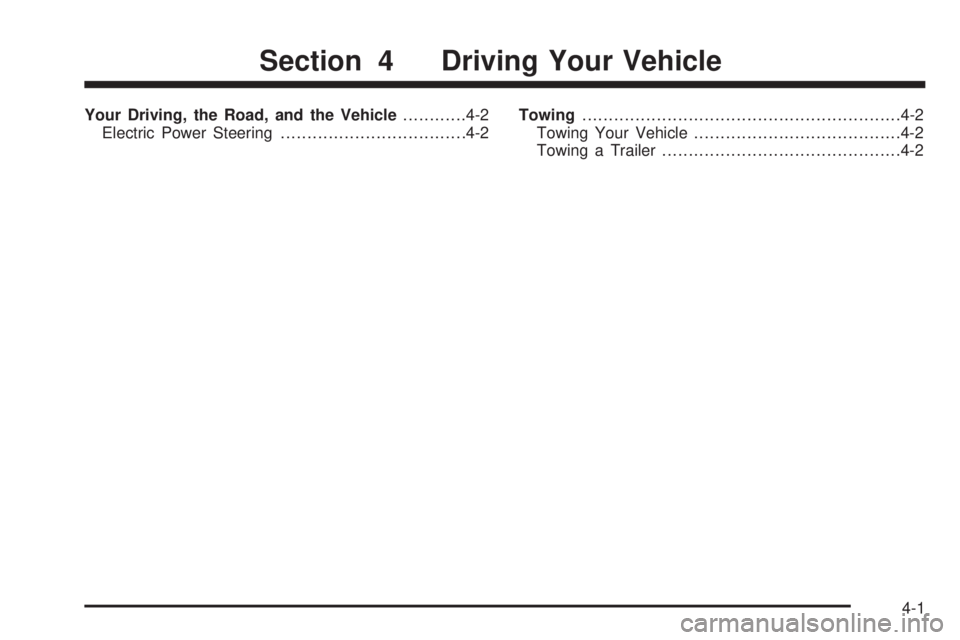
Your Driving, the Road, and the Vehicle............4-2
Electric Power Steering...................................4-2Towing............................................................4-2
Towing Your Vehicle.......................................4-2
Towing a Trailer.............................................4-2
Section 4 Driving Your Vehicle
4-1
Page 34 of 94

Your Driving, the Road, and
the Vehicle
Electric Power Steering
This vehicle has On-Demand Electric-Assist Power
Steering instead of conventional full-time hydraulic
power steering. It uses electricity supplied by the same
battery which is re-charged by the regenerative
braking system.
Because the system is On-Demand Electric-Assist,
energy is used only when the steering wheel is turned,
or when the steering gear is used to help isolate the
forces of rough roads. This system does not use power
steering fluid, making it maintenance-free.
Towing
Towing Your Vehicle
Consult your dealer/retailer or a professional towing
service if the disabled vehicle needs to be towed.
Towing a Trailer
For more information, see “Towing a Trailer” in the
owner manual Index.
Weight of the Trailer
How heavy can a trailer safely be?
It depends on how the rig is used. For example, speed,
altitude, road grades, outside temperature and how
much the vehicle is used to pull a trailer are all
important. It can depend on any special equipment on
the vehicle, and the amount of tongue weight the vehicle
can carry.
4-2
Page 37 of 94
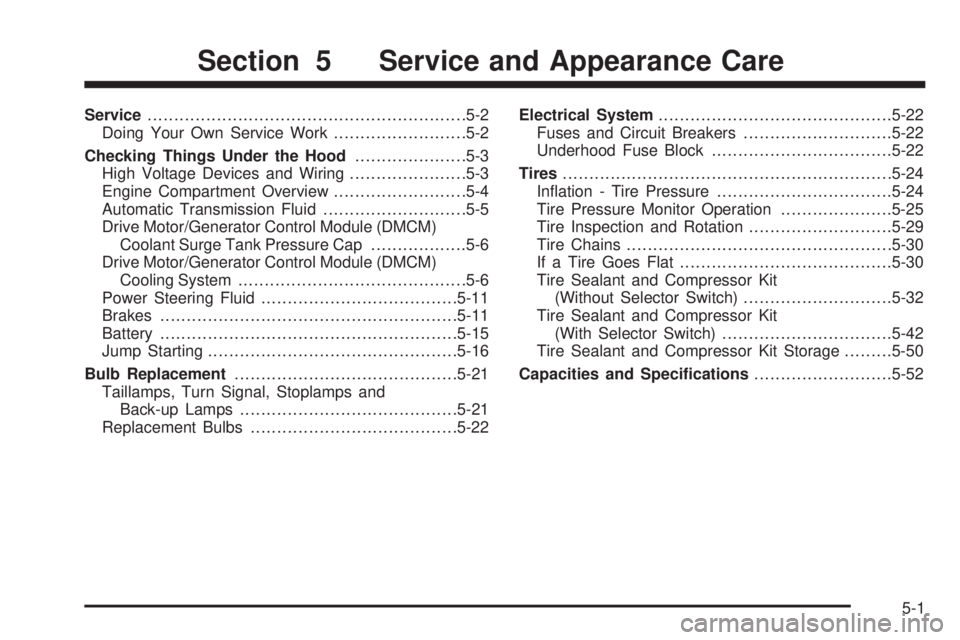
Service............................................................5-2
Doing Your Own Service Work.........................5-2
Checking Things Under the Hood.....................5-3
High Voltage Devices and Wiring......................5-3
Engine Compartment Overview.........................5-4
Automatic Transmission Fluid...........................5-5
Drive Motor/Generator Control Module (DMCM)
Coolant Surge Tank Pressure Cap..................5-6
Drive Motor/Generator Control Module (DMCM)
Cooling System...........................................5-6
Power Steering Fluid.....................................5-11
Brakes........................................................5-11
Battery........................................................5-15
Jump Starting...............................................5-16
Bulb Replacement..........................................5-21
Taillamps, Turn Signal, Stoplamps and
Back-up Lamps.........................................5-21
Replacement Bulbs.......................................5-22Electrical System............................................5-22
Fuses and Circuit Breakers............................5-22
Underhood Fuse Block..................................5-22
Tires..............................................................5-24
Inflation - Tire Pressure.................................5-24
Tire Pressure Monitor Operation.....................5-25
Tire Inspection and Rotation...........................5-29
Tire Chains..................................................5-30
If a Tire Goes Flat........................................5-30
Tire Sealant and Compressor Kit
(Without Selector Switch)............................5-32
Tire Sealant and Compressor Kit
(With Selector Switch)................................5-42
Tire Sealant and Compressor Kit Storage.........5-50
Capacities and Speci�cations..........................5-52
Section 5 Service and Appearance Care
5-1
Page 47 of 94
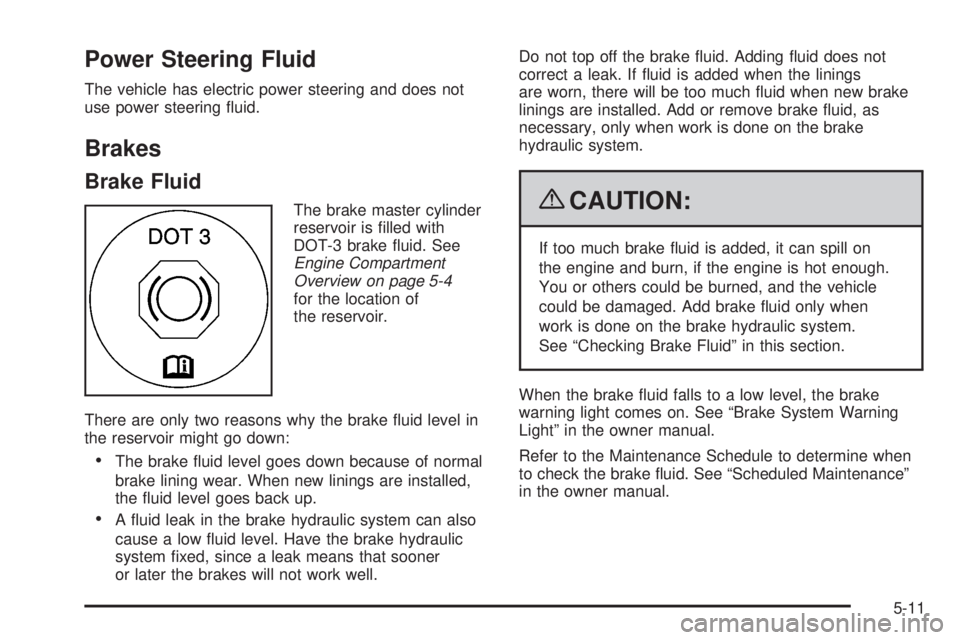
Power Steering Fluid
The vehicle has electric power steering and does not
use power steering fluid.
Brakes
Brake Fluid
The brake master cylinder
reservoir is filled with
DOT-3 brake fluid. See
Engine Compartment
Overview on page 5-4
for the location of
the reservoir.
There are only two reasons why the brake fluid level in
the reservoir might go down:
•The brake fluid level goes down because of normal
brake lining wear. When new linings are installed,
the fluid level goes back up.
•A fluid leak in the brake hydraulic system can also
cause a low fluid level. Have the brake hydraulic
system fixed, since a leak means that sooner
or later the brakes will not work well.Do not top off the brake fluid. Adding fluid does not
correct a leak. If fluid is added when the linings
are worn, there will be too much fluid when new brake
linings are installed. Add or remove brake fluid, as
necessary, only when work is done on the brake
hydraulic system.
{CAUTION:
If too much brake fluid is added, it can spill on
the engine and burn, if the engine is hot enough.
You or others could be burned, and the vehicle
could be damaged. Add brake fluid only when
work is done on the brake hydraulic system.
See “Checking Brake Fluid” in this section.
When the brake fluid falls to a low level, the brake
warning light comes on. See “Brake System Warning
Light” in the owner manual.
Refer to the Maintenance Schedule to determine when
to check the brake fluid. See “Scheduled Maintenance”
in the owner manual.
5-11
Page 66 of 94
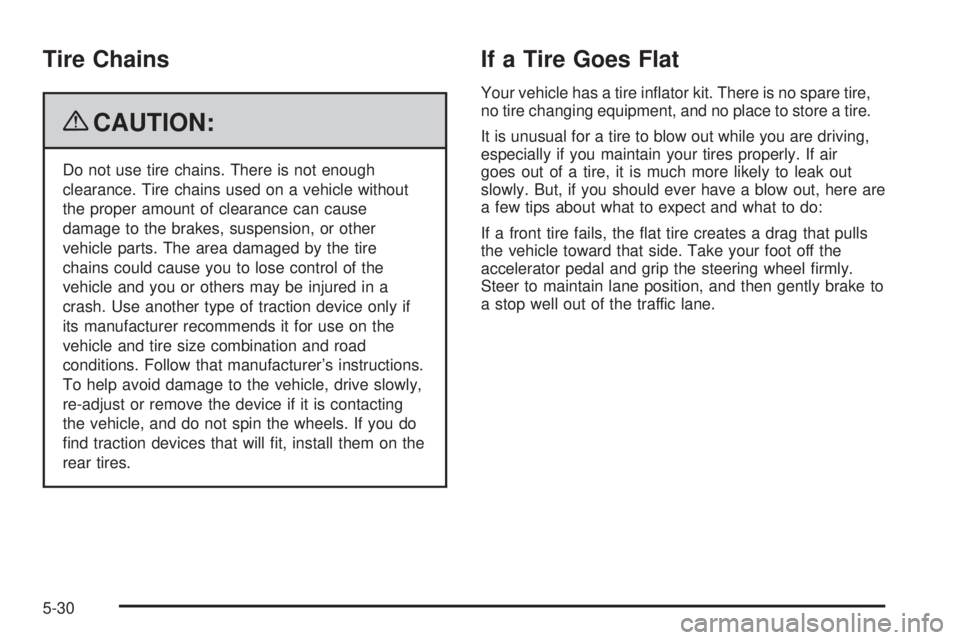
Tire Chains
{CAUTION:
Do not use tire chains. There is not enough
clearance. Tire chains used on a vehicle without
the proper amount of clearance can cause
damage to the brakes, suspension, or other
vehicle parts. The area damaged by the tire
chains could cause you to lose control of the
vehicle and you or others may be injured in a
crash. Use another type of traction device only if
its manufacturer recommends it for use on the
vehicle and tire size combination and road
conditions. Follow that manufacturer’s instructions.
To help avoid damage to the vehicle, drive slowly,
re-adjust or remove the device if it is contacting
the vehicle, and do not spin the wheels. If you do
find traction devices that will fit, install them on the
rear tires.
If a Tire Goes Flat
Your vehicle has a tire inflator kit. There is no spare tire,
no tire changing equipment, and no place to store a tire.
It is unusual for a tire to blow out while you are driving,
especially if you maintain your tires properly. If air
goes out of a tire, it is much more likely to leak out
slowly. But, if you should ever have a blow out, here are
a few tips about what to expect and what to do:
If a front tire fails, the flat tire creates a drag that pulls
the vehicle toward that side. Take your foot off the
accelerator pedal and grip the steering wheel firmly.
Steer to maintain lane position, and then gently brake to
a stop well out of the traffic lane.
5-30
Page 67 of 94
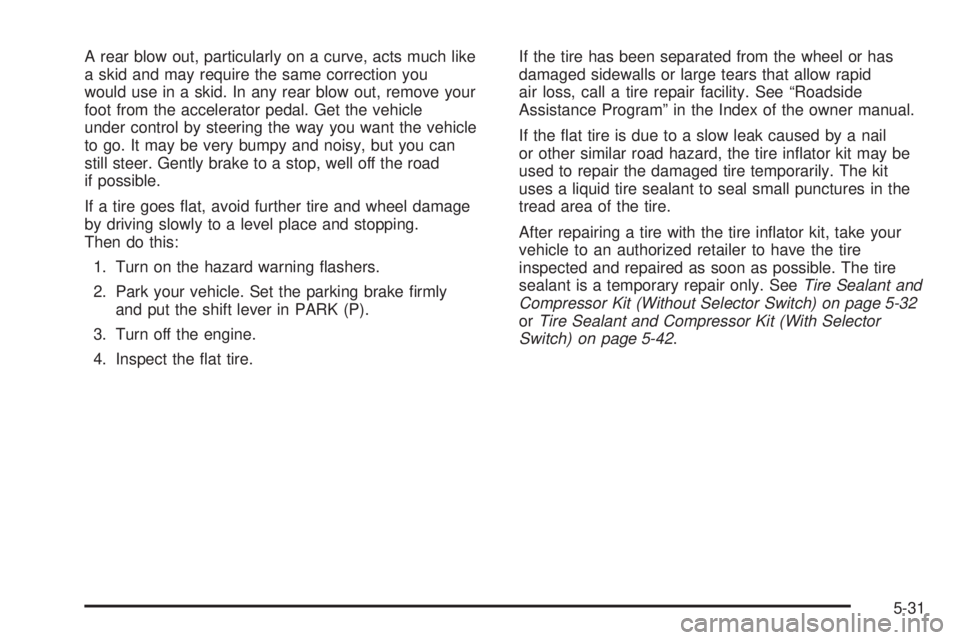
A rear blow out, particularly on a curve, acts much like
a skid and may require the same correction you
would use in a skid. In any rear blow out, remove your
foot from the accelerator pedal. Get the vehicle
under control by steering the way you want the vehicle
to go. It may be very bumpy and noisy, but you can
still steer. Gently brake to a stop, well off the road
if possible.
If a tire goes flat, avoid further tire and wheel damage
by driving slowly to a level place and stopping.
Then do this:
1. Turn on the hazard warning flashers.
2. Park your vehicle. Set the parking brake firmly
and put the shift lever in PARK (P).
3. Turn off the engine.
4. Inspect the flat tire.If the tire has been separated from the wheel or has
damaged sidewalls or large tears that allow rapid
air loss, call a tire repair facility. See “Roadside
Assistance Program” in the Index of the owner manual.
If the flat tire is due to a slow leak caused by a nail
or other similar road hazard, the tire inflator kit may be
used to repair the damaged tire temporarily. The kit
uses a liquid tire sealant to seal small punctures in the
tread area of the tire.
After repairing a tire with the tire inflator kit, take your
vehicle to an authorized retailer to have the tire
inspected and repaired as soon as possible. The tire
sealant is a temporary repair only. SeeTire Sealant and
Compressor Kit (Without Selector Switch) on page 5-32
orTire Sealant and Compressor Kit (With Selector
Switch) on page 5-42.
5-31
Page 92 of 94
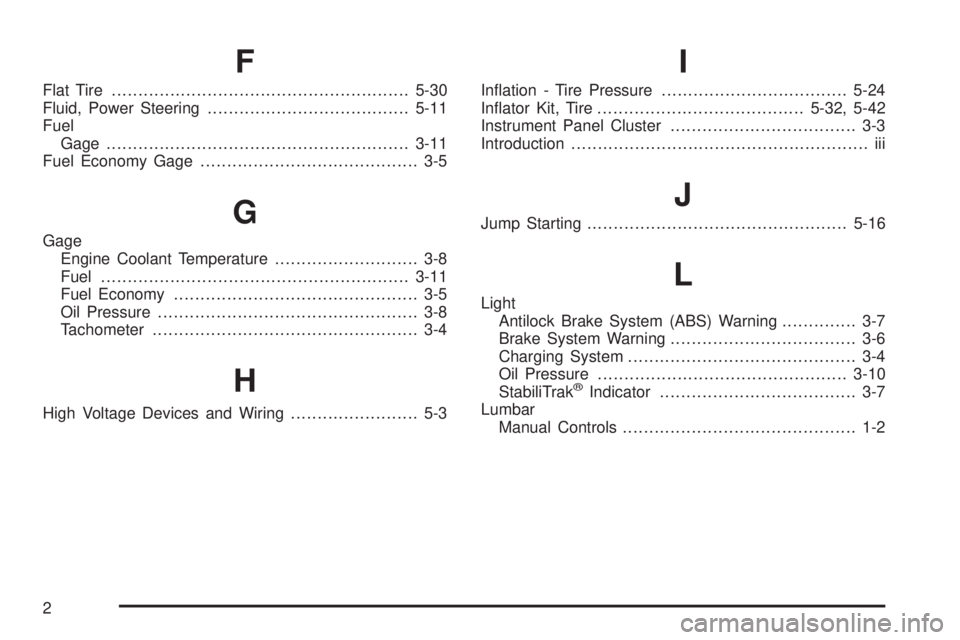
F
Flat Tire........................................................5-30
Fluid, Power Steering......................................5-11
Fuel
Gage .........................................................3-11
Fuel Economy Gage......................................... 3-5
G
Gage
Engine Coolant Temperature........................... 3-8
Fuel..........................................................3-11
Fuel Economy.............................................. 3-5
Oil Pressure................................................. 3-8
Tachometer.................................................. 3-4
H
High Voltage Devices and Wiring........................ 5-3
I
Inflation - Tire Pressure...................................5-24
Inflator Kit, Tire.......................................5-32, 5-42
Instrument Panel Cluster................................... 3-3
Introduction........................................................ iii
J
Jump Starting.................................................5-16
L
Light
Antilock Brake System (ABS) Warning.............. 3-7
Brake System Warning................................... 3-6
Charging System........................................... 3-4
Oil Pressure...............................................3-10
StabiliTrak
®Indicator..................................... 3-7
Lumbar
Manual Controls............................................ 1-2
2
Page 93 of 94
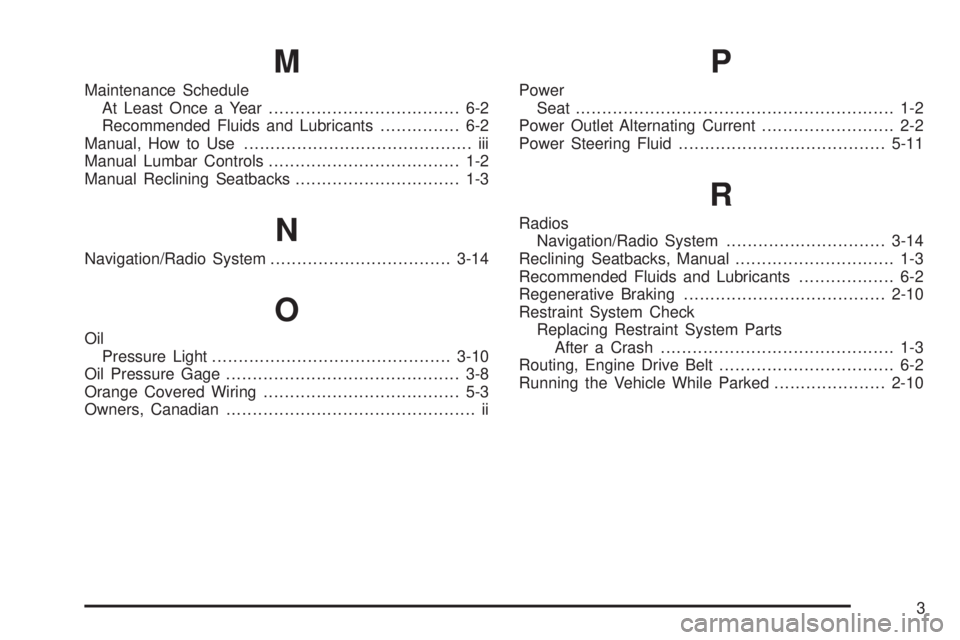
M
Maintenance Schedule
At Least Once a Year.................................... 6-2
Recommended Fluids and Lubricants............... 6-2
Manual, How to Use........................................... iii
Manual Lumbar Controls.................................... 1-2
Manual Reclining Seatbacks............................... 1-3
N
Navigation/Radio System..................................3-14
O
Oil
Pressure Light.............................................3-10
Oil Pressure Gage............................................ 3-8
Orange Covered Wiring..................................... 5-3
Owners, Canadian............................................... ii
P
Power
Seat............................................................ 1-2
Power Outlet Alternating Current......................... 2-2
Power Steering Fluid.......................................5-11
R
Radios
Navigation/Radio System..............................3-14
Reclining Seatbacks, Manual.............................. 1-3
Recommended Fluids and Lubricants.................. 6-2
Regenerative Braking......................................2-10
Restraint System Check
Replacing Restraint System Parts
After a Crash............................................ 1-3
Routing, Engine Drive Belt................................. 6-2
Running the Vehicle While Parked.....................2-10
3